
|
Sale 108
NY International Coin Auction January 8-10, 2019
| Lot |
Photo |
Description |
Realized |
Lot 115 |
 |
Judaea, Procuratorial. Valerius Gratus. Æ Prutah (1.81 g), 15-26 CE. Jerusalem, in the name of Julia, RY 4 of Tiberius (18/9 CE). [IO]YΛIA, vine leaf and small bunch of grapes. Rev. Narrow-necked amphora with scroll handles; across field, date (L Δ). Hendin 1336; TJC 326. Scarce. Extremely Fine. Estimate Value $200 - UP
From the Palm Desert Collection. Purchased from Superior in the 1970s.
View details and enlarged photos
| Realized
$528 |
Lot 116 |
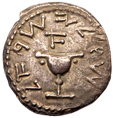 |
Judaea, The Jewish War. Silver Shekel (13.54 g), 66-70 CE. Jerusalem, year 1 (66/7 CE). 'Shekel of Israel' (Paleo-Hebrew), ritual chalice with wide, smooth rim, pellet on either side, and flat base with pearled ends; above, '[year] 1'. Rev. 'Jerusalem [the] holy' (Paleo-Hebrew), staff with three pomegranate buds, round base. Hendin 1354; TJC 187. Deutsch die 11. A splendid example of the popular first year with pleasing old cabinet toning. Extremely Fine. Estimate Value $7,500 - UP
From the S. Moussaieff Collection, This lot has been officially exported from Israel through the Israel Antiquities Authority.
The silver shekel of the first year of the Jewish War against Rome is perhaps one of the most iconic coins in the ancient Jewish coin series. The chalice on the obverse is widely believed to represent the omer cup used in the Jerusalem Temple while the reverse may represent a staff with three pomegranates. The pomegranate was a traditional symbol of Jewish priestly authority. It has been argued recently, however, that earlier scholars may have been right to understand this type not as an allegorical emblem of the priesthood but as a representation of the budding almond staff of Aaron that was kept in the Ark of the Covenant.
View details and enlarged photos
| Realized
$13,800 |
Lot 117 |
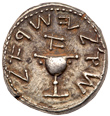 |
Judaea, The Jewish War. Silver Shekel (14.14 g), 66-70 CE. Jerusalem, year 1 (66/7 CE). 'Shekel of Israel' (Paleo-Hebrew), ritual chalice with wide, smooth rim, pellet on either side, and flat base with pearled ends; above, '[year] 1'. Rev. 'Jerusalem [the] holy' (Paleo-Hebrew), staff with three pomegranate buds, round base. Hendin 1354; TJC 187; Deutsch die 25. Boldly struck, well centered on excellent metal. Lightly toned. Extremely Fine. Estimate Value $5,000 - UP
From the Palm Desert Collection. Ex Superior (21 November 1983), 24.
View details and enlarged photos
| Realized
$16,200 |
Lot 118 |
 |
Judaea, The Jewish War. Silver 1/2 Shekel (6.75 g), 66-70 CE. Jerusalem, year 1 (66/7 CE). 'Half of a shekel' (Paleo-Hebrew), ritual chalice with wide, smooth rim, pellet on either side, and flat base with pearled ends; above, '[year] 1'. Rev. 'Jerusalem [the] holy' (Paleo-Hebrew), staff with three pomegranate buds, round base. Hendin 1355; TJC 188; Deutsch die 1. Boldly struck, excellent metal. Pleasing old cabinet tone. Choice Very Fine. Estimate Value $7,500 - UP
From the Palm Desert Collection. Purchased from Superior in the 1980s.
The dramatic first year (May 66-March 67 CE) of the Jewish War against Rome gave some hope that the Jewish rebels might actually win their independence. Late in 66 CE they defeated the XII Legion commanded by the Roman procurator Cestius Gallus. Some of the silver coinage struck in this year may perhaps have been produced from the booty carried off by the victorious Jews in this confrontation. Unfortunately, this Roman defeat led to Vespasian's transfer to the theater of conflict and the eventual quashing of the revolt in the Galilee.
View details and enlarged photos
| Realized
$23,400 |
Lot 119 |
 |
Judaea, The Jewish War. Silver 1/2 Shekel (6.77 g), 66-70 CE. Jerusalem, year 1 (66/7 CE). 'Half of a shekel' (Paleo-Hebrew), ritual chalice with wide, smooth rim, pellet on either side, and flat base with pearled ends; above, '[year] 1'. Rev. 'Jerusalem [the] holy' (Paleo-Hebrew), staff with three pomegranate buds, round base. Hendin 1355; TJC 188; Deutsch die 1. Well struck and unusually well centered. Lightly toned. Sound metal. Choice Very Fine. Estimate Value $7,500 - UP
From the Palm Desert Collection. Purchased from Superior in the 1980s.
View details and enlarged photos
| Realized
$23,400 |
Lot 120 |
 |
Judaea, The Jewish War. Silver Shekel (13.86 g), 66-70 CE. Jerusalem, year 2 (67/8 CE). 'Shekel of Israel' (Paleo-Hebrew), ritual chalice with pearled rim, the base raised by projections on both ends; above, 'year 2'. Rev. 'Jerusalem the holy' (Paleo-Hebrew), staff with three pomegranate buds, round base. Hendin 1358; TJC 193; Deutsch die 145. Boldly struck, well centered, and luster still present. Superb Extremely Fine. Estimate Value $5,000 - UP
From the Palm Desert Collection. Ex Superior (21 November 1983), 28.
The second year of the Jewish War against Rome (April 67-March 68 CE) saw the Zealot-led rebellion in the Galilee crushed by the forces of Vespasian, soon to become the imperial successor of Nero. During this campaign, the future historian Josephus was famously placed in command of the fortress at Gamla. When it was clear that all was lost, the leadership agreed not to surrender to the Romans, choosing instead to die by killing one other by lot. When all were dead but Josephus and one other man, they both fearing death, surrendered to the Romans. Thanks to this, Josephus lived on for many years, writing his account of the war responsible for coins like this shekel.
View details and enlarged photos
| Realized
$8,700 |
Lot 121 |
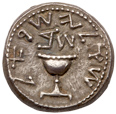 |
Judaea, The Jewish War. Silver Shekel (14.17 g), 66-70 CE. Jerusalem, year 2 (67/8 CE). 'Shekel of Israel' (Paleo-Hebrew), ritual chalice with pearled rim, the base raised by projections on both ends; above, 'year 2'. Rev. 'Jerusalem the holy' (Paleo-Hebrew), staff with three pomegranate buds, round base. Hendin 1358; TJC 193. Deutsch obverse die 14 (apparently an unpublished reverse marriage.) Boldly struck and well centered. Nicely toned. Extremely Fine / Very Fine. Estimate Value $5,000 - UP
From the S. Moussaieff Collection, This lot has been officially exported from Israel through the Israel Antiquities Authority.
View details and enlarged photos
| Realized
$6,300 |
Lot 122 |
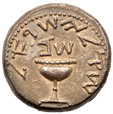 |
Judaea, The Jewish War. Silver Shekel (13.75 g), 66-70 CE. Jerusalem, year 2 (67/8 CE). 'Shekel of Israel' (Paleo-Hebrew), ritual chalice with pearled rim, the base raised by projections on both ends; above, 'year 2'. Rev. 'Jerusalem the holy' (Paleo-Hebrew), staff with three pomegranate buds, round base. Hendin 1358; TJC 193. Deutsch die 112. Well struck, well centered and nicely toned. Choice Very Fine. Estimate Value $3,500 - UP
From the S. Moussaieff Collection, This lot has been officially exported from Israel through the Israel Antiquities Authority.
View details and enlarged photos
| Realized
$8,400 |
Lot 123 |
 |
Judaea, The Jewish War. Silver Shekel (14.04 g), 66-70 CE. Jerusalem, year 2 (67/8 CE). 'Shekel of Israel' (Paleo-Hebrew), ritual chalice with pearled rim, the base raised by projections on both ends; above, 'year 2'. Rev. 'Jerusalem the holy' (Paleo-Hebrew), staff with three pomegranate buds, round base. Hendin 1358; TJC 193. Deutsch die 31. Boldly struck and nicely centered. We note some fine die scratches, many as made. Toned. (this coin should improve if properly cleaned). Very Fine. Estimate Value $3,000 - UP
From the S. Moussaieff Collection, This lot has been officially exported from Israel through the Israel Antiquities Authority.
View details and enlarged photos
| Realized
$6,300 |
Lot 124 |
 |
Judaea, The Jewish War. Silver 1/2 Shekel (6.89 g), 66-70 CE. Jerusalem, year 2 (67/8 CE). 'Half of a shekel' (Paleo-Hebrew), ritual chalice with pearled rim, the base raised by projections on both ends; above, 'year 2'. Rev. 'Jerusalem the holy' (Paleo-Hebrew), staff with three pomegranate buds, round base. Hendin 1359; TJC 195; Deutsch die 23. Boldly struck on excellent metal, well centered, and nicely toned. Choice Very Fine. Estimate Value $7,500 - UP
From the Palm Desert Collection. Purchased from Superior in the 1970s or 1980s.
View details and enlarged photos
| Realized
$20,400 |
Lot 125 |
 |
Judaea, The Jewish War. Silver 1/2 Shekel (6.69 g), 66-70 CE. Jerusalem, year 2 (67/8 CE). 'Half of a shekel' (Paleo-Hebrew), ritual chalice with pearled rim, the base raised by projections on both ends; above, 'year 2'. Rev. 'Jerusalem the holy' (Paleo-Hebrew), staff with three pomegranate buds, round base. Hendin 1359; TJC 195. Deutsch die 11. Boldly struck and well centered. Attractively toned. A very choice example. About Extremely Fine. Estimate Value $7,500 - UP
From the Palm Desert Collection. Purchased from Superior in the 1980s.
View details and enlarged photos
| Realized
$22,200 |
Lot 126 |
 |
Judaea, The Jewish War. Æ Prutah (2.61 g), 66-70 CE. Jerusalem, year 2 (67/8 CE). 'Year two' (Paleo-Hebrew), amphora with broad rim and two handles. Rev. 'The freedom of Zion' (Paleo-Hebrew), vine leaf on small branch with tendril. Hendin 1360; TJC 196. Dark green patina. Exceptional. Superb Extremely Fine. Estimate Value $250 - UP
From the Palm Desert Collection. Purchased from Superior in the 1970s or 1980s.
Although struck by the Jewish rebels against Rome, the the prutot of the Jewish War take much of their typological inspiration from the earlier coinages struck for Judaea by the Roman praetorial government. The amphora and vine leaf types come very close to those used for an issue of Valerius Gratus in 17/8 CE.
View details and enlarged photos
| Realized
$690 |
Lot 127 |
 |
Judaea, The Jewish War. Silver Shekel (14.17 g), 66-70 CE. Jerusalem, year 3 (68/9 CE). 'Shekel of Israel' (Paleo-Hebrew), ritual chalice with pearled rim, the base raised by projections on both ends; above, 'year 3'. Rev. 'Jerusalem the holy' (Paleo-Hebrew), staff with three pomegranate buds, round base. Hendin 1361; TJC 202; Deutsch die 87. A spectacular specimen! Boldly struck on excellent metal, loaded with luster and magnificent iridescent toning. Worthy of a record bid. Mint State. Estimate Value $7,000 - UP
From the Palm Desert Collection. Ex Superior (21 November 1983), 38.
The third year of the Jewish War saw some slight respite from the Roman advance as the death of Nero plunged the Roman Empire into a civil war into which Vespasian was drawn. However, violence in Jerusalem reached new heights as the Zealot leaders of the crushed northern revolt waged their own civil war against Ananus ben Ananus, the leader of the more moderate priestly authorities. This factional conflict resulted in an ignominious siege of Jerusalem by the Zealots and the slaughter of Ananus and his adherents. Jerusalem the holy, as it is described on the shekels, had been defiled by the blood of its own people before ever the Romans entered the city.
View details and enlarged photos
| Realized
$15,600 |
Lot 128 |
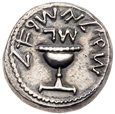 |
Judaea, The Jewish War. Silver Shekel (14.25 g), 66-70 CE. Jerusalem, year 3 (68/9 CE). 'Shekel of Israel' (Paleo-Hebrew), ritual chalice with pearled rim, the base raised by projections on both ends; above, 'year 3'. Rev. 'Jerusalem the holy' (Paleo-Hebrew), staff with three pomegranate buds, round base. Hendin 1361; TJC 202; Deutsch die 50. Boldly struck on a full wide flan with complete legends and excellent margins. Excellent metal. Nicely toned. Extremely Fine. Estimate Value $5,000 - UP
From the Palm Desert Collection. Purchased from Superior in the 1970s.
View details and enlarged photos
| Realized
$8,100 |
Lot 129 |
 |
Judaea, The Jewish War. Silver 1/2 Shekel (6.44 g), 66-70 CE. Jerusalem, year 3 (68/9 CE). 'Half of a shekel' (Paleo-Hebrew), ritual chalice with pearled rim, the base raised by projections on both ends; above, 'year 3'. Rev. 'Jerusalem the holy' (Paleo-Hebrew), staff with three pomegranate buds, round base. Hendin 1362; TJC 203; Deutsch die 19. Lightly toned. Choice Very Fine. Estimate Value $7,500 - UP
From the Palm Desert Collection. Purchased from Superior in the 1970s or 1980s.
View details and enlarged photos
| Realized
$21,000 |
Lot 130 |
 |
Judaea, The Jewish War. Silver 1/2 Shekel (6.72 g), 66-70 CE. Jerusalem, year 3 (68/9 CE). 'Half of a shekel' (Paleo-Hebrew), ritual chalice with pearled rim, the base raised by projections on both ends; above, 'year 3'. Rev. 'Jerusalem the holy' (Paleo-Hebrew), staff with three pomegranate buds, round base. Hendin 1362; TJC 203; Deutsch die 18. Mostly well struck in excellent silver. Lightly toned. Extremely Fine. Estimate Value $7,500 - UP
From the Palm Desert Collection. Purchased from Superior in the 1970s.
View details and enlarged photos
| Realized
$21,600 |
Lot 131 |
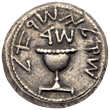 |
Judaea, The Jewish War. Silver Shekel (13.45 g), 66-70 CE. Jerusalem, year 4 (69/70 CE). 'Shekel of Israel' (Paleo-Hebrew), ritual chalice with pearled rim, the base raised by projections on both ends; above, 'year 4'. Rev. 'Jerusalem the holy' (Paleo-Hebrew), staff with three pomegranate buds, round base. Hendin 1364; TJC 207; Deutsch die 22. Boldly struck and well centered on a nice full flan. Lightly toned. A marvelous example of this very rare year 4 shekel. Extremely Fine. Estimate Value $20,000 - UP
From the Palm Desert Collection.
The disasters brought by the internecine conflict among the Jewish rebel factions in the third year of the Jewish War turned into horror in the fourth (April 69-March 70 CE) as Titus marched south against Jerusalem and laid siege to the heavily fortified city. The Jews trapped within faced the torment of starvation. Hunger stalked the streets and compelled the Jerusalemites to eat the leather from their shoes, belts, and even the coverings of their shields. Some even descended to cannibalism in order to survive. By this point, the possibility of redeeming Zion from the Romans, as indicated by the coin legend, was long past and the tragic fall of the Holy City was soon to come.
View details and enlarged photos
| Realized
$42,000 |
Lot 132 |
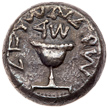 |
Judaea, The Jewish War. Silver Shekel (13.49 g), 66-70 CE. Jerusalem, year 4 (69/70 CE). 'Shekel of Israel' (Paleo-Hebrew), ritual chalice with pearled rim, the base raised by projections on both ends; above, 'year 4'. Rev. 'Jerusalem the holy' (Paleo-Hebrew), staff with three pomegranate buds, round base. Hendin 1364; TJC 207. Well centered with full legends. Toned. Very Fine. Estimate Value $12,000 - UP
From the Palm Desert Collection. Purchased from D. Hendin in the 1980s.
View details and enlarged photos
| Realized
$32,400 |
Lot 133 |
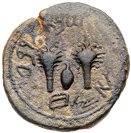 |
Judaea, The Jewish War. Æ Half Shekel (17.23 g), 66-70 CE. Jerusalem, year 4 (69/70 CE). 'Year four, half' (Paleo-Hebrew), two lulav branches flanking ethrog (citron). Rev. 'To the redemption of Zion' (Paleo-Hebrew), palm tree with two bunches of dates, flanked by baskets with dates. Hendin 1367; TJC 211. Very Rare. Tan and brown patina. Tiny edge flan fault at one o'clock as made. Very Fine. Estimate Value $2,500 - UP
From the Palm Desert Collection. Purchased from Superior in the 1970s.
View details and enlarged photos
| Realized
$10,800 |
Lot 134 |
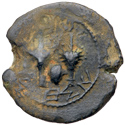 |
Judaea, The Jewish War. Æ Half (10.30 g), 66-70 CE. Jerusalem, year 4 (69/70 CE). 'Year four, half' (Paleo-Hebrew), two lulav branches flanking ethrog (citron). Rev. 'To the redemption of Zion' (Paleo-Hebrew), palm tree with two bunches of dates, flanked by baskets with dates. Hendin 1367; TJC 211. Very Rare. Struck on a somewhat irregular shaped flan. Greenish-brown patina. Very Fine. Estimate Value $2,500 - UP
From the S. Moussaieff Collection, This lot has been officially exported from Israel through the Israel Antiquities Authority.
The introduction of large bronze denominations in the final year (April 69-March 70 CE) of the Jewish War illustrates the desperate state of the Jewish rebels as they struggled to defend Jerusalem against the Roman forces led by Titus and against the violent rifts in the rebel leadership. Silver denominations from this disastrous year are very rare, suggesting that silver had become more difficult to obtain in the Holy City. Josephus even provides us with the scene of inhabitants so desperate that they took to swallowing their silver and gold. These large bronzes must have filled in the gaps in the rebel currency system as the horrific end of the war loomed closer; indeed, they carry legends identifying them as a "half," presumably indicating a fiduciary token standing in for a proper silver half shekel.
View details and enlarged photos
| Realized
$9,600 |
Lot 135 |
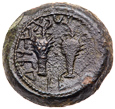 |
Judaea, The Jewish War. Æ Quarter Shekel (8.98 g), 66-70 CE. Jerusalem, year 4 (69/70 CE). 'Year four, quarter' (Paleo-Hebrew), two lulav branches. Rev. 'To the redemption of Zion' (Paleo-Hebrew), etrog. Hendin 1368; TJC 213. Rare. Dark brown patina. Very Fine. Estimate Value $1,000 - UP
From the Palm Desert Collection. Purchased from Superior in the 1970s.
The lulav branches and etrog types depicted on the token bronze quarter shekels of the fourth year (April 69-March 70 CE) of the Jewish War refer to Sukkot, the Feast of Tabernacles, which was both a harvest celebration and a commemoration of the deliverance of the Israelites from slavery in Egypt. This typology may appear at this time because the rebels had reached the point of no return and had no hope of surviving the coming Roman onslaught without divine aid.
View details and enlarged photos
| Realized
$1,440 |
Lot 136 |
 |
Judaea, The Jewish War. Æ Eighth (5.69 g), 66-70 CE. Jerusalem, year 4 (69/70 CE). 'Year four' (Paleo-Hebrew), lulav branch flanked by an etrog on either sider. Rev. 'To the redemption of Zion' (Paleo-Hebrew), chalice with pearled rim. Hendin 1369; TJC 214. Chocolate-brown patina. Very Fine. Estimate Value $250 - UP
From the Palm Desert Collection. Purchased from Superior in the 1970s or 1980s.
The bronze eighth denomination of the fourth year (April 69-March 70 CE) of the Jewish War is remarkable for its use of the pearled chalice type on the reverse when this had previously been reserved for silver shekels and fractions. It may signal that this denomination, although unmarked, was intended as a token representing a value in silver.
View details and enlarged photos
| Realized
$432 |
Lot 137 |
 |
Judaea, The Jewish War. Æ Eighth (5.09 g), 66-70 CE. Jerusalem, year 4 (69/70 CE). 'Year four' (Paleo-Hebrew), lulav branch flanked by an etrog on either sider. Rev. 'To the redemption of Zion' (Paleo-Hebrew), chalice with pearled rim. Hendin 1369; TJC 214. Well struck and choice. Dark brown patina. Very Fine. Estimate Value $250 - UP
From the Palm Desert Collection. Purchased from Superior in the 1970s.
View details and enlarged photos
| Realized
$660 |
Lot 138 |
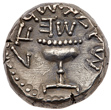 |
Judaea, The Jewish War. Silver Shekel (14.14 g), 66-70 CE. Year 5 (April-Augustus 70 CE). 'Shekel of Israel' around, 'year 5' above, ritual chalice with pearled rim. Rev. 'Jerusalem the holy', sprig of three pomegranates. Hendin 1370; TJC 215 Deutsch die 12. Boldly struck and perfectly centered. Lightly toned. Candidate for "the pick from the Baldwin group". Superb Extremely Fine. Estimate Value $25,000 - UP
From the Palm Desert Collection. Ex Sotheby's; Baldwin Group.
Year 5 shekels are the rarest of all the shekels minted during the Jewish War. There were only four months that year to strike them before Titus captured Jerusalem and destroyed the Temple in the Fall of 70 CE. Nevertheless, during the last months of the siege when all commerce as well as the striking of bronze coins came to a halt, it was important to continue striking coins in silver in order for the Jews to continue to pay the half-shekel Temple tax, as commanded in Exodus 30.13. Several year 5 shekels were among the coins excavated at Masada, one of the most famous rebel strongholds against the Romans, which notoriously held out against them for three more years after Vespasian and Titus celebrated their Triumph in 71 CE. It is therefore known that at least some Jewish fighters were able to escape Jerusalem just before it fell. After the war, it was forbidden to use coins of the revolt, so the shekels were melted down into ingots, for their silver value.See Hendin p. 363 for a concise and interesting summary of the Baldwin Hoard.Josephus (de Bello Judaico 7.320-406) tells us that when at length it became evident that the Romans would prevail, the rebel commander of the zealot group known as the Sicarii, Eleazar ben Ya'ir, convinced his men to kill their wives and children and then to commit suicide, thereby depriving the Romans of the glory of taking them captives and sparing themselves from slavery.
View details and enlarged photos
| Realized
$55,200 |
Lot 139 |
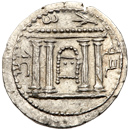 |
Judaea, Bar Kokhba Revolt. Silver Sela (14.14 g), 132-135 CE. Year 1 (132/3 CE). 'Jerusalem' (Paleo-Hebrew), tetrastyle façade of the Temple of Jerusalem; show bread table or Ark of the Covenant in chest form with semicircular lid and short legs, seen from a narrow side. Rev. 'Year one of the redemption of Israel' (Paleo-Hebrew), lulav with etrog at left. Hendin 1373; Mildenberg 1 (O1/R3); TJC 218. Very rare. An absolutely incredible example! Boldly struck and well centered with nice wide margins. Virtually as struck! Traces of luster still evident. One of the finest in existence. Superb Extremely Fine. Estimate Value $75,000 - UP
From the S. Moussaieff Collection, This lot has been officially exported from Israel through the Israel Antiquities Authority.
The Bar Kokhba War (132-135 CE) broke out when Hadrian decided to refound Jerusalem - still largely ruined from the disastrous Jewish Revolt (66-73 CE) - as the pagan city of Aelia Capitolina. Although Jewish discontent had already erupted into violence in the Diaspora during the reign of Trajan, the Jews of Judaea seem not to have risen up against the Romans until this threatened abomination against the site of the Temple and the surrounding Holy City. The leader of this new rebellion, which took the form of a bloody guerilla war, was a certain Simon bar Kokhba who had messianic pretensions and gained a reputation as a great warrior. Unfortunately, although Bar Kokhba managed to make Hadrian pay dearly for Aelia Capitolina, when the emperor assembled an army of six full legions to invade Judaea in 134 CE the rebellion was soon crushed. In punishment almost the entirety of Judaea was laid waste by the victorious Romans and the Jewish population destroyed or driven out. In order to fund the rebellion, Bar Kokhba and his supporters used what circulating coins they could find or capture from the Romans and restruck them with new types more suitable for their revolutionary purposes. The most remarkable and desirable of the new types were used for the silver sela overstruck primarily on Syrian and Phoenician tetradrachms. The obverse features a depiction of the façade of the Jerusalem Temple with an uncertain object inside, which has been variously interpreted as the show bread table or the Ark of the Covenant. It has been suggested that the Bar Kokhba rebels actually intended to rebuild the Temple, but the presence of either the show bread table or the Ark - items lost at the end of the Jewish Revolt or earlier - seems to imply that the image represents the idea of the Temple to rally support rather than any real edifice planned by the Bar Kokhba rebels. The reverse type looks back to the coinage of the Jewish Revolt in its depiction of the lulav and etrog associated with the Festival of Tabernacles.
View details and enlarged photos
| Realized
$78,000 |
Lot 140 |
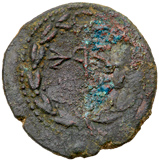 |
Judaea, Bar Kokhba Revolt. Æ Large Bronze (17.34 g), 132-135 CE. Year 1 (132/3 CE). 'Jerusalem' (Paleo-Hebrew) within wreath. Rev. 'Year one of the redemption of Israel' (Paleo-Hebrew), amphora with two handles. Hendin 1375; Mildenberg 12 (O3/R4); TJC 221. Very Rare Well centered with mostly uniform reddish-brown patina. Very Fine. Estimate Value $10,000 - UP
From the S. Moussaieff Collection, This lot has been officially exported from Israel through the Israel Antiquities Authority.
View details and enlarged photos
| Realized
$9,840 |
Lot 141 |
 |
Judaea, Bar Kokhba Revolt. Æ Medium Bronze (8.04 g), 132-135 CE. Year 1 (132/3 CE). 'Simon, Prince of Israel' (Paleo-Hebrew), palm branch within wreath. Reverse: 'Year one of the redemption of Israel' (Paleo-Hebrew), wide lyre with four strings. Hendin 1377; Mildenberg 24 (O1/R5); TJC 223. Dark reddish-green patina. SupEF. Estimate Value $750 - UP
From the Palm Desert Collection. Purchased from SKA, Bern, in the 1980s.
The reverse type of this middle bronze denomination of the first year of the Bar Kokhba War is commonly identified as a nevel, a stringed instrument thought to have been similar to the Greek chelys. Although the kinnor - a related instrument similar to the Greek kithara - was prescribed as an instrument to be played in the Jerusalem Temple, the nevel had an even more important status in some rabbinical Jewish traditions. It was said that the world was actually sung into existence to the accompaniment of a perfect 22-stringed nevel. The reverberating notes of these strings subsequently became the 22 letters of the Hebrew alphabet. Considering the messianic flavor of the Bar Kokhba revolt one wonders whether the nevel type alludes to a new creation for Judaea free from Roman oppression. The palm branch on the obverse may perhaps celebrate the early victories of the Bar Kokhba rebels during "year one of the redemption of Israel."
View details and enlarged photos
| Realized
$1,500 |
Lot 142 |
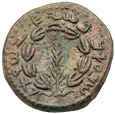 |
Judaea, Bar Kokhba Revolt. Æ Medium Bronze (11.56 g), 132-135 CE. Year 1 (132/3 CE). 'Simon, Prince of Israel' (Paleo-Hebrew), palm branch within wreath. Rev. 'Year one of the redemption of Israel' (Paleo-Hebrew), wide lyre with six strings. Hendin 1377; Mildenberg 23 (O1/R4); TJC 223. Light olive and greenish-brown patina. A marvelous specimen. Superb Extremely Fine. Estimate Value $750 - UP
From the Palm Desert Collection. Purchased from D. Hendin in the 1980s.
View details and enlarged photos
| Unsold |
Lot 143 |
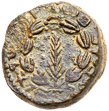 |
Judaea, Bar Kokhba Revolt. Æ Medium Bronze (11.83 g), 132-135 CE. Year 1 (132/3 CE). 'Simon, Prince of Israel' (Paleo-Hebrew), palm branch within wreath. Rev. 'Year one of the redemption of Israel' (Paleo-Hebrew), wide lyre with six strings. Hendin 1377; Mildenberg 23 (O1/R4); TJC 223. Pale green and brown patina. Extremely Fine. Estimate Value $500 - UP
From the Palm Desert Collection.
View details and enlarged photos
| Realized
$900 |
Lot 144 |
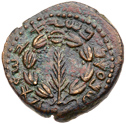 |
Judaea, Bar Kokhba Revolt. Æ Medium Bronze (9.72 g), 132-135 CE. Year 1 (132/3 CE). 'Simon, Prince of Israel' (Paleo-Hebrew), palm branch within wreath. Reverse: 'Year one of the redemption of Israel' (Paleo-Hebrew), wide lyre with five strings. Hendin 1377; Mildenberg 20 (O1/R1); TJC 223. Glossy reddish-brown patina and boldly struck. ChVF. Estimate Value $500 - UP
From the Palm Desert Collection. Purchased from Superior in the 1980s.
View details and enlarged photos
| Realized
$1,050 |
Lot 145 |
 |
Judaea, Bar Kokhba Revolt. Æ Medium Bronze (13.48 g), 132-135 CE. Year 1 (132/3 CE). 'Simon, Prince of Israel' (Paleo-Hebrew), palm branch within wreath. Reverse: 'Year one of the redemption of Israel' (Paleo-Hebrew), wide lyre with five strings. Hendin 1377; Mildenberg 26 (O1/R7); TJC 223. Uniform dark green-brown patina. EF. Estimate Value $500 - UP
From the Palm Desert Collection. Purchased from Superior in the 1980s.
View details and enlarged photos
| Realized
$990 |
Lot 146 |
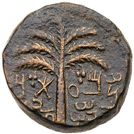 |
Judaea, Bar Kokhba Revolt. Æ Medium Bronze (25.19 g), 132-135 CE. Year 1 (132/3 CE). 'Simon, Prince of Israel' (Paleo-Hebrew), seven-branched palm tree with two bunches of dates. Reverse: 'Year one of the redemption of Israel' (Paleo-Hebrew), vine leaf on tendril. Hendin 1378; Mildenberg 34a (O1/R1); TJC 222. Overstruck on a huge, heavy weight host coins, double the weight of a normal year 1 middle bronze. First such example we have seen. VF. Estimate Value $1,000 - UP
From the Palm Desert Collection. Ex Lawson Collection (Superior, 3 June 1985), 2229.
The vine leaf reverse of this middle bronze denomination of the first yearof the Bar Kokhba War takes its inspiration from the prutot of the earlier failed Jewish Revolt (66-73 CE) that employed a similar type. In this way the Bar Kokhba War was presented as a continuation of the earlier fight and lent it legitimacy in historical terms. The palm tree was a symbol of Judaea going back at least to the time of the Jewish Revolt since it regularly appears on Roman coins in conjunction with Jewish captives under Vespasian and his successors. The seven branches consciously recall the seven arms of the menorah, perhaps the Jewish symbol par excellence. The palm tree was also prominent on coins of the Galileean city of Sepphoris, which became an important center of rabbinical Judaism after the Bar Kokhba War.
View details and enlarged photos
| Realized
$5,520 |
Lot 147 |
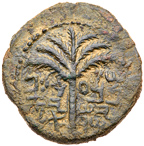 |
Judaea, Bar Kokhba Revolt. Æ Medium Bronze (11.23 g), 132-135 CE. Year 1 (132/3 CE). 'Simon, Prince of Israel' (Paleo-Hebrew), seven-branched palm tree with two bunches of dates. Rev. 'Year one of the redemption of Israel' (Paleo-Hebrew), vine leaf on tendril. Hendin 1378; Mildenberg 44 (O2/R7); TJC 222. Well struck on a huge flan. Medium brown-green patina. Choice Very Fine. Estimate Value $400 - UP
From the Palm Desert Collection. Ex Superior (10 August 1983), 138.
View details and enlarged photos
| Realized
$990 |
Lot 148 |
 |
Judaea, Bar Kokhba Revolt. Æ Small Bronze (6.83 g), 132-135 CE. Year 1 (132/3 CE). 'Eleazar the priest' (Paleo-Hebrew), seven-branched palm tree with two bunches of dates. Reverse: 'Year one of the redemption of Israel' (Paleo-Hebrew), bunch of grapes with branch and small leaf. Hendin 1380; Mildenberg 150 (O1/R4); TJC 224. Boldly struck on a nice broad flan. Dark green and reddish-brown patina. EF. Estimate Value $300 - UP
From the Palm Desert Collection. Purchased from D. Hendin in the 1980s.
The small bronze denomination of the first year (132/3 CE) of the Bar Kokhba War is typologically connected to the middle bronze palm tree denominations. The palm tree emblem of Judaea appears again on the obverse, but on the reverse the vine leaf of the middle bronze denomination is replaced by a grape bunch. In contrast to the medium bronze denominations, the small denomination does not name Simon bar Kokhba, but Eleazar the priest.
View details and enlarged photos
| Realized
$660 |
Lot 149 |
 |
Judaea, Bar Kokhba Revolt. Æ Small Bronze (6.68 g), 132-135 CE. Year 1 (132/3 CE). 'Eleazar the priest' (Paleo-Hebrew), seven-branched palm tree with two bunches of dates. Reverse: 'Year one of the redemption of Israel' (Paleo-Hebrew), bunch of grapes with branch and small leaf. Hendin 1380; Mildenberg 150 (O1/R4); TJC 224. An exceptional specimen. Reddish-brown patina. ChEF. Estimate Value $300 - UP
From the Palm Desert Collection. Purchased from Superior in the 1970s or 1980s.
View details and enlarged photos
| Realized
$1,140 |
Lot 150 |
 |
Judaea, Bar Kokhba Revolt. Æ Small Bronze (8.03 g), 132-135 CE. Year 1 (132/3 CE). 'Eleazar the priest' (Paleo-Hebrew), seven-branched palm tree with two bunches of dates. Reverse: 'Year one of the redemption of Israel' (Paleo-Hebrew), bunch of grapes with branch and small leaf. Hendin 1380; Mildenberg 150 (O1/R4); TJC 224. Chocolate brown patina. EF. Estimate Value $300 - UP
From the Palm Desert Collection. Purchased from C. Anselem in the 1980s.
View details and enlarged photos
| Realized
$600 |
Lot 151 |
 |
Judaea, Bar Kokhba Revolt. Æ Small Bronze (6.20 g), 132-135 CE. Year 1 (132/3 CE). 'Eleazar the priest' (Paleo-Hebrew), seven-branched palm tree with two bunches of dates. Reverse: 'Year one of the redemption of Israel' (Paleo-Hebrew), bunch of grapes with branch and small leaf. Mildenberg 147 (O1/R1); TJC 224; Hendin 1380a. Wonderful reddish-brown patina. Rarely seen this choice. SupEF. Estimate Value $300 - UP
From the Palm Desert Collection. Purchased from Superior in the 1980s.
This example of the year 1 small bronze denomination exhibits the irregularity of a retrograde paleo-Hebrew inscription. Evidently the engraver forgot that he needed to cut the letters backwards into the die in order for them to appear properly on the finished coin. Also interesting is that it shares its reverse die with the silver zuzim of year 1, cf. Mildenberg series II, 1, die O1.
View details and enlarged photos
| Realized
$660 |
Lot 152 |
 |
Judaea, Bar Kokhba Revolt. Silver Zuz (3.28 g), 132-135 CE. Hybrid Year One and Year Two. (132/3-133/4 CE). 'Year one of the redemption of Israel' (Paleo-Hebrew), bunch of grapes with branch and small leaf. Rev. 'Year two of the freedom of Israel' (Paleo-Hebrew), palm branch. Mildenberg 10 (O2/R8); TJC 237; Hendin 1382. Luster still present. Boldly struck and perfectly centered. Very rare. Mint State. Estimate Value $10,000 - UP
From the S. Moussaieff Collection, This lot has been officially exported from Israel through the Israel Antiquities Authority.
A hybrid coin struck from two reverse dies, one from the first year (132/3 CE) and the other from the second year (133/4 CE) of the Bar Kokhba War. This sort of reverse muling, which appears to have been peculiar to the zuz denomination, may have taken place late in the second year when the tide was beginning to turn decisively against the Bar Kokhba rebels and the coins were struck under difficult conditions with little concern for quality control. These mules are important from a technical perspective because they show that in the Bar Kokhba mint(s) obverse and reverse dies were completely interchangeable.
View details and enlarged photos
| Realized
$30,000 |
Lot 153 |
 |
Judaea, Bar Kokhba Revolt. Silver Zuz (2.99 g), 132-135 CE. Hybrid Year One and Year Two. (132/3-133/4 CE). 'Sma' (Paleo-Hebrew) within wreath of thin branches wrapped around eight almonds, with a medallion at top and tendrils at bottom. Rev. 'Eleazar the priest' (Paleo-Hebrew), fluted jug with handle on left; in right field, palm branch. Hendin 1384; Mildenberg 4 (O3/R2); TJC 235. Boldly struck. Toned with some very minor reddish deposit spots on the reverse borders (removable). Superb Extremely Fine. Estimate Value $5,000 - UP
From the Palm Desert Collection. Purchased from Superior in the 1980s.
This hybrid zuz mules two obverse dies of different years of the Bar Kokhba War. The wreathed obverse die with the abbreviated name of Simon bar Kokhba belongs to the second year (132/3 CE) while the jug obverse die belongs to the first year and names Eleazar the priest. It has been suggested that Simon's name is abbreviated here (and on other coins) in such a way that it could also be read as the word shema ("hear"), the first word in Deuteronomy 6: 4 ("Hear, O Israel: The Lord is our God, the Lord is One.") which is the centerpiece of morning and evening Jewish prayer known as the Shema Yisrael. Based on this view it has been further proposed that the Shema prayer served as a rallying cry for the Bar Kokhba rebels.
View details and enlarged photos
| Realized
$9,600 |
Lot 154 |
 |
Judaea, Bar Kokhba Revolt. Silver Sela (13.58 g), 132-135 CE. Year 2 (133/4 CE). 'Simon' (Paleo-Hebrew), tetrastyle façade of the Temple of Jerusalem; show bread table or Ark of the Covenant in chest form with semicircular lid and short legs, seen from a narrow side; above façade, cross. Rev. 'Year two of the freedom of Israel' (Paleo-Hebrew), lulav with etrog at left. Hendin 1387a; Mildenberg 17 (O4/R11); TJC 230. Boldly struck on a nice broad flan. Toned. Extremely Fine. Estimate Value $4,000 - UP
From the Palm Desert Collection. Ex Superior (14 December 1987), Dr. Feori Pipito Coll., 584.
The obverse of this year 2 sela issue depicts the Jerusalem Temple but now features a + shape above the façade whereas this space was taken up by part of the paleo-Hebrew legend on the issues of the first year of the Bar Kokhba War. There is a great deal of controversy over whether this added symbol was intended to depict a star and advertise Simon bar Kokhba's supposed messianic ambitions. The patronymic of the rebel leader was actually bar Kosiba but he assumed the name bar Kokhba (literally "son of a star") as his nom de guerre because of its association with the messianic prophecy of Numbers 24:17.
View details and enlarged photos
| Realized
$10,200 |
Lot 155 |
 |
Judaea, Bar Kokhba Revolt. Silver Sela (14.43 g), 132-135 CE. Year 2 (133/4 CE). 'Simon' (Paleo-Hebrew), tetrastyle façade of the Temple of Jerusalem; show bread table or Ark of the Covenant in chest form with semicircular lid and short legs, seen from a narrow side; above façade, star. Rev. 'Year two of the freedom of Israel' (Paleo-Hebrew), lulav with etrog at left. Hendin 1388; Mildenberg 40 (O10/R28); TJC 233. Rare. Clear undertype portrait of Galba. A fantastic coin. Extremely Fine. Estimate Value $6,000 - UP
From the S. Moussaieff Collection; Ex Superior's A. Bromberg pt. 2, Dec. 10, 1992, lot 411. This lot has been officially exported from Israel through the Israel Antiquities Authority.
View details and enlarged photos
| Realized
$27,600 |
Lot 156 |
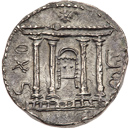 |
Judaea, Bar Kokhba Revolt. Silver Sela (14.18 g), 132-135 CE. Year 2 (133/4 CE). 'Simon' (Paleo-Hebrew), tetrastyle façade of the Temple of Jerusalem; show bread table or Ark of the Covenant in chest form with semicircular lid and short legs, seen from a narrow side; above façade, star. Rev. 'Year two of the freedom of Israel' (Paleo-Hebrew), lulav with etrog at left. Hendin 1388; Mildenberg 28 (O6/R19); TJC 233. Toned. Extremely Fine. Estimate Value $4,000 - UP
From the Palm Desert Collection. Purchased from Superior in the 1980s.
View details and enlarged photos
| Realized
$9,300 |
Lot 157 |
 |
Judaea, Bar Kokhba Revolt. Silver Zuz (3.14 g), 132-135 CE. Year 2 (133/4 CE). 'Sm' (Paleo-Hebrew) within wreath of thin branches wrapped around eight almonds, with a medallion at top and tendrils at bottom. Rev. 'Year two of the freedom of Israel' (Paleo-Hebrew), wide lyre with three strings and four dots on sound box. Hendin 1389; Mildenberg 15 (O3/R10); TJC 238. Well toned. Rare. Choice Very Fine. Estimate Value $2,000 - UP
From the Palm Desert Collection. Purchased from Superior in the 1980s; Earlier from Munzen und Medallen A.G., Basel.
This zuz of the second year (133/4 CE) of the Bar Kokhba War reflects interesting iconographic and political developments as the threat of a massive Roman invasion of Judaea loomed. The wreathed paleo-Hebrew legend type naming Simon bar Kokhba has evolved from the preceding large bronzes of the first year (132/3 CE), which is notable because the zuzim of that year originally carried the name of Eleazar whom Simon may have killed in a fit of rage at his betrayal. The musical instrument on the reverse, probably the kinnor used in the Temple, also appeared previously on medium bronzes of the first year. It is unclear why these particular bronze-inspired types were employed for silver zuzim in the second year when they were still in use for large and medium bronze denominations, respectively.
View details and enlarged photos
| Realized
$2,640 |
Lot 158 |
 |
Judaea, Bar Kokhba Revolt. Silver Zuz (3.08 g), 132-135 CE. Year 2 (133/4 CE). 'Sm' (Paleo-Hebrew) within wreath of thin branches wrapped around eight almonds, with a medallion at top and tendrils at bottom. Rev. 'Year two of the freedom of Israel' (Paleo-Hebrew), fluted jug with handle on left; in right field, willow branch. Hendin 1391; Mildenberg 34 (O5'/R22); TJC 250. Toned. Extremely Fine. Estimate Value $1,000 - UP
From the Palm Desert Collection. Purchased from D. Hendin, August, 1987.
Silver zuzim such as this this feature the name of Simon bar Kokhba in paleo-Hebrew surrounded by a wreath as on other apparently early zuzim issues of the second year (133/4 CE) of the Bar Kokhba War. However, the reverse type featuring a fluted jug and willow branch copies the design used for the obverse of zuzim struck in the first year (132/3 CE).
View details and enlarged photos
| Realized
$2,640 |
Lot 159 |
 |
Judaea, Bar Kokhba Revolt. Silver Zuz (3.11 g), 132-135 CE. Year 2 (133/4 CE). 'Sm' (Paleo-Hebrew) within wreath of thin branches wrapped around eight almonds, with a medallion at top and tendrils at bottom. Rev. 'Year two of the freedom of Israel' (Paleo-Hebrew), fluted jug with handle on left; in right field, willow branch. Hendin 1391; Mildenberg 34 (O5'/R22); TJC 250. Well struck on a large wide flan. Toned. Extremely Fine. Estimate Value $1,000 - UP
From the Palm Desert Collection. Purchased from D. Hendin in the 1980s.
View details and enlarged photos
| Realized
$1,860 |
Lot 160 |
 |
Judaea, Bar Kokhba Revolt. Silver Zuz (3.15 g), 132-135 CE. Year 2 (133/4 CE). 'Sm' (Paleo-Hebrew) within wreath of thin branches wrapped around eight almonds, with a medallion at top and tendrils at bottom. Rev. 'Year two of the freedom of Israel' (Paleo-Hebrew), fluted jug with handle on left; in right field, willow branch. Hendin 1391; Mildenberg 33 (O5'/R21); TJC 250. Lightly toned. Extremely Fine. Estimate Value $500 - UP
From the Palm Desert Collection. Purchased from H. Berk in the 1980s.
View details and enlarged photos
| Realized
$1,260 |
Lot 161 |
 |
Judaea, Bar Kokhba Revolt. Silver Zuz (3.14 g), 132-135 CE. Year 2 (133/4 CE). 'Sm' (Paleo-Hebrew) within wreath of thin branches wrapped around eight almonds, with a medallion at top and tendrils at bottom. Rev. 'Year two of the freedom of Israel' (Paleo-Hebrew), fluted jug with handle on left; in right field, willow branch. Hendin 1391; Mildenberg 34 (O5'/R22); TJC 250. Lightly toned. Choice Very Fine. Estimate Value $500 - UP
From the Palm Desert Collection. Purchased from Superior in the 1970s.
View details and enlarged photos
| Realized
$1,110 |
Lot 162 |
 |
Judaea, Bar Kokhba Revolt. Silver Zuz (3.17 g), 132-135 CE. Year 2 (133/4 CE). 'Simon', bunch of grapes with leaf and tendril. Rev. 'Year two of the freedom of Israel' (Paleo-Hebrew), upright palm branch. Hendin 1394; Mildenberg 42 (O8/R24); TJC 248. Portions of the legend and portrait of Trajan visible on the obverse. Toned. Extremely Fine. Estimate Value $1,500 - UP
From the Palm Desert Collection. Purchased from D. Hendin in the 1980s.
View details and enlarged photos
| Realized
$3,120 |
Lot 163 |
 |
Judaea, Bar Kokhba Revolt. Silver Zuz (3.21 g), 132-135 CE. Year 2 (133/4 CE). 'Simon', bunch of grapes with leaf and tendril. Rev. 'Year two of the freedom of Israel' (Paleo-Hebrew), upright palm branch. Hendin 1394; Mildenberg 42 (O8/R24); TJC 248. Attractively toned. Extremely Fine. Estimate Value $1,000 - UP
From the Palm Desert Collection. Purchased from Superior in the 1980s.
View details and enlarged photos
| Realized
$1,260 |
Lot 164 |
 |
Judaea, Bar Kokhba Revolt. Silver Zuz (3.18 g), 132-135 CE. Year 2 (133/4 CE). 'Simon', bunch of grapes with leaf and tendril. Rev. 'Year two of the freedom of Israel' (Paleo-Hebrew), upright palm branch. Hendin 1394; Mildenberg 49.8 (O10/R29); TJC 248. Understriking visible. Delicately toned. About Extremely Fine. Estimate Value $500 - UP
From the Palm Desert Collection. Ex Abraham Bromberg Collection, pt. I (Superior, 5 December 1991), 147; Bank Leu stock, 1974.
View details and enlarged photos
| Realized
$1,440 |
|
|